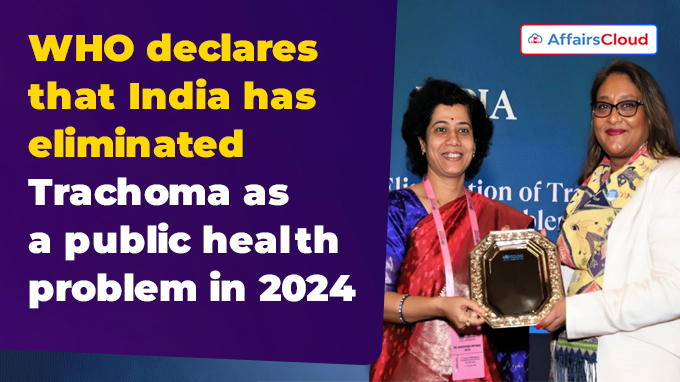 The World Health Organization (WHO) has declared that the Government of India(GoI) has eliminated Trachoma as a public health problem. India received this honor at the 77th Regional Conference of World Health Organization (WHO) South East Asia Region held in New Delhi.
The World Health Organization (WHO) has declared that the Government of India(GoI) has eliminated Trachoma as a public health problem. India received this honor at the 77th Regional Conference of World Health Organization (WHO) South East Asia Region held in New Delhi.
- It has become the 3rd country in the South-East Asia Region after Nepal and Myanmar to secure this milestone.
- Besides, 19 other countries globally have also been successful in eliminating trachoma. These are Benin, Cambodia, China, Gambia, Ghana, the Islamic Republic of Iran, Iraq, the Lao People’s Democratic Republic, Malawi, Mali, Mexico, Morocco, Myanmar, Nepal, Oman, Pakistan, Saudi Arabia, Togo, and Vanuatu.
Note : According to the WHO, nearly 150 million people were affected by the eye infection, which caused nearly six million of them to lose their eyesight.
What is Trachoma?
i.Trachoma is an eye disease caused by infection with the bacterium Chlamydia trachomatis.
- The infection spreads from person to person through contaminated fingers, infected objects and flies that have come into contact with discharge from the eyes or nose of an infected person.
ii.It can spread through environmental factors like poor hygiene, overcrowded households, and inadequate access to water, and sanitation facilities.
iii.Repeated infections in childhood lead to damaging of the inner side of the upper eyelids, resulting in inward turning of the eyelid margin, with the eyelashes touching the eyeball.
- This is a painful condition known as trachomatous trichiasis and if left untreated, it can result in visual impairment and blindness.
Criteria Elimination of trachoma as a public health problem:
i.A prevalence of trachomatous trichiasis “unknown to the health system” is less than 0.2% in adults aged 15 years and older (approximately 1 case per 1000 total population)
ii.A prevalence of trachomatous inflammation follicular in children aged 1–9 years of less than 5%, sustained for at least 2 years in the absence of ongoing antibiotic mass treatment, in each formerly endemic district.
iii.The existence of a system able to identify and manage incident trachomatous trichiasis cases, using defined strategies, with evidence of appropriate financial resources to implement those strategies.
Key Initiatives Taken by India :
i.In 1963, the Ministry of Health and Family Welfare(MoHFW), GoI introduced a National Trachoma Control Program with support from WHO and United Nations Children’s Fund (UNICEF).
- The community-based interventions to eliminate trachoma consisted of surgical treatment, topical antibiotic treatment, and Water, Sanitation and Hygiene (WASH) initiatives, along with health education awareness to decrease transmission.
ii.The National Program for Control of Blindness and Visual Impairment (NPCBVI) was introduced in 1976 and the National Trachoma Control Program activities were integrated with activities of NPCBVI.
iii.In 2005, trachoma caused 4% of all cases of blindness in India. By 2018, the prevalence of trachoma was down to 0.008%.
iv.WHO SAFE(adoption of surgery, antibiotics, facial hygiene, environmental cleanliness etc.)strategy was carried out that included adoption of surgery, antibiotics, facial hygiene, environmental cleanliness etc.
- As a result, in 2017, India was declared free frominfectious Trachoma.
v.The National Trachomatous Trichiasis (TT only) Survey was carried out in 200 endemic districts of the country under NPCBVI from 2021-24, which was made compulsory by WHO in order to declare that India has eliminated Trachoma as a public health problem.
Recent Related News :
The Ministry of Ayush (Ayurveda, Yoga and Naturopathy, Unani, Siddha, Sowa Rigpa and Homoeopathy), Government of India (GoI) and the World Health Organization (WHO) have signed a donor agreement during an event in Geneva, Switzerland.
- This donor agreement is part of a USD250 million investment from India in support of the establishment of the WHO Global Traditional Medicine Centre (GTMC) in 2022
About World Health Organization (WHO):
Director-General(DG) – Tedros Adhanom Ghebreyesus
Headquarters – Geneva, Switzerland
Founded – 7 April 1948
Member countries – 194 member states




